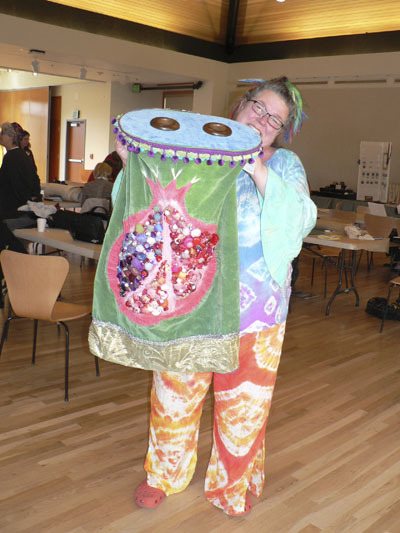Vashon artist Sooze Bloom deLeon Grossman has created glass, textile and garden art for years and has sewn since she was young, but no project has made her sweat as much her most recent endeavor: a mantle to cover a history-making new Torah.
When Seattle’s Kadima Reconstrictionist Jewish Community decided in 2000 that it was time for the congregation to have its own Torah, the progressive organization used the opportunity to do something special: It commissioned the first Torah ever scribed by women.
Traditionally, only men are Torah scribes. Women haven’t been allowed to learn the sacred Judaic art, Grossman said. Kadima’s Torah, scribed collectively by several women, would be groundbreaking and historic. And like any Torah, the sacred scroll would need a mantle, an ornate fabric cover.
Wendy Graff, who headed the Women’s Torah Project, doesn’t remember whether she approached Grossman or Grossman volunteered to sew the mantle. However, she does remember knowing that Grossman, who was a member of Kadima and taught Sunday school there for a number of years, was the perfect person to create the mantle.
“She’s the most creative person I know. … The kids in her Sunday school classes would make prayer caps out of beautiful fabric,” Graff said. “She was the natural person.”
Grossman, outgoing and spirited yet also humble, was more modest about her abilities. The artist, who sells her fares at Good Merchandise and the Heron’s Nest, said she was thrilled to contribute to the project but worried others may have been more qualified for the job.
“There were a lot of fabric artists who wanted to make mantles,” Grossman said. “The community said, ‘No, you can’t make the first mantle,’ because I was doing it.”
Years passed between 2002, when Grossman volunteered her services, and when she actually picked up a needle. As five women from across the country learned Hebrew and were trained, sometimes in secret, to scribe the ancient words, Grossman said she nearly forgot about her upcoming duties. That is, until the world began to take notice of the project.
“As we got closer and closer to the Torah being finished, it got more public. There were more eyes on it,” she said. “I began to wish fervently that I had let a professional textile artist take the project to begin with. I thought the end result would have been more finished and more in the realm of what people expected.”
The end result, however, was more than what anyone expected, Graff said. Not only did Grossman create a beautifully ornate mantle to cover Kadima’s Torah, she said, but the mantle embodied the spirit of the Women’s Torah Project itself.
At the beginning of the project, Grossman solicited Jewish women to send in pieces of clothing or other belongings to contribute to the mantle. Over eight years, she received around 70 pieces of clothing, gloves, blankets and curtains from all over the world, often accompanied by photos, stories and handwritten notes about the women they belonged to.
A Colorado woman sent a piece of her grandmother’s wedding dress, the same one she wrapped her infant daughter in during her naming ceremony.
The first person to become bat mitzvahed at Kadima donated a piece of her belly dancing outfit.
The children of two different Holocaust survivors mailed swatches of clothes that belonged to the now deceased German women.
The first lesbian couple to marry in Canada sent a piece of their huppa, the canopy they stood under during their wedding ceremony.
Each piece of fabric that came Grossman’s way became a seed in a bright pink pomegranate, a traditional Jewish symbol, on the forest green mantle she created.
“There are just all kinds of pieces, and they’re all sent in with such love,” Grossman said. “Even if there’s not a big traumatic story, it’s all traumatic in the sense of the loving, intimate connection between generations of women.”
The finished mantle, the product of 150 hours of work, was embellished with 300-year-old African trade beads, modern Italian beads and vintage buttons from all over Europe and America. “It’s really quite encrusted,” Grossman said.
Graff said the mantle, which she called “breathtakingly beautiful,” is imbued with the history of pioneering Jewish women who went before those involved in the Torah project.
“It embodies the spirit we wanted this Torah to have — the inclusion and honoring of our matriarch. It couldn’t have been more right for this project,” she said.
Once she finished the mantle, Grossman helped sew together the 62 parchment panels that made up the women’s Torah. She was also one of many in the Kadima community who helped fill in a letter at the end of the Torah, involving as many people as possible in the project, and she was there when the holy book was first read aloud.
“There was huge amounts of singing, that was very moving,” she said. “Lots of tears were shed. Lots and lots of songs were sung.”
Benjamin Grossman, her husband, compiled a book from the stories and photos that were sent along with the fabric. As people viewed the Torah, its mantle and the accompanying book at a recent public service, Grossman saw some people weep.
“The feedback has been really lovely — all the way from little girls who are entranced to even the oldest people that have seen it and have been very interested in how I came to the design decision. … People have just received it really warmly,” she said, “and very delightedly.”



